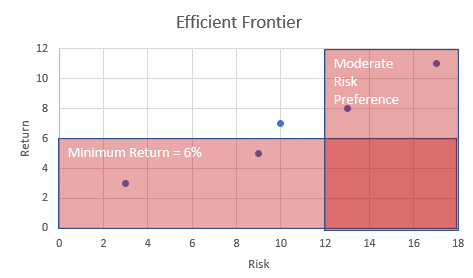Investing can feel overwhelming for any investor—particularly in a volatile market. However, having a strategic investment strategy backed by a comprehensive financial plan can help provide both understanding and comfort in those up and down times. And just like your plan, your asset allocation should be customized based on your preferred approach, goals and risk appetite.
Establishing your goals
One of the most important steps to building your asset allocation is to establish your goals, along with a timeline, with your financial team. This is critical as well-defined goals enable your team to determine the required rates of return to meet them. From building wealth, saving for your kids’ college and building your retirement, to preserving your assets while building a legacy plan, your goals and life stage will dictate your asset allocation.
Your preferences should play a significant role in establishing a strategic portfolio strategy. Some people may be interested in aligning their investments with their values, while others may have geographic, size or style preferences. Nearly any preference can be accommodated.
You will likely have multiple goals and values that are top-of-mind when you begin discussing your asset allocation. Once outlined, you will need to prioritize these with your team and then discuss your risk tolerance and how that plays into your strategy.
Understand your risk tolerance
When looking at your risk tolerance, you want to determine the least amount of risk you need to assume to achieve your goals within your stated time horizon. The more time you have, usually the more risk you should be willing to take on.

The longer your time horizon, the lower the risk associated with holding stocks. In the chart to the left, you can see that as you extend the holding period of the S&P 500 (using monthly data going back to 1927), the less volatile the annualized returns become. By the time you reach 15-year holding periods, it’s a reasonably flat line. The statistics play out in the table below:

As you extend your holding period, the extreme results begin to mute, with both best and worst results becoming less extreme. Additionally, the batting average (the percentage of positive returns) increases. By the time you’re at a 15-year holding period, you have only lost money 3.7% of the time, most of which occurred during the depression era.
Your personality and background will also play a factor in your risk tolerance. For example, if you are from an entrepreneurial background where you’ve experienced business ups and downs, you might be more comfortable with a higher risk portfolio than someone who grew up in a household that struggled to make ends meet.
Another important distinction is your ability to take risk. Those who have established a larger base of investable assets will likely have more options than one who is just beginning their investing journey. That said, just because someone can take more risk, doesn’t mean they want to or should—be honest in your willingness and comfort level so your financial team can create the right asset allocation for you.
It’s also important to note that your risk tolerance may change as you journey through life. Make this discussion a part of your regular financial review with your financial team so you can adjust items as needed.
Choosing and customizing your asset allocation
Now that you’ve established your goals, timeline and risk tolerance, it’s time to build your asset allocation.

This graph represents possible portfolios available in terms of annual return as well as risk (or variation) around that average annual return. For example, if through the process of financial planning, your team establishes that your goals require a 6% average return, you can set a lower bound that excludes portfolios that won’t meet your goals. If through the profiling process, your team establishes that you can’t take on more than 12% annual volatility, this creates another constraint that limits portfolio choices. Your team would then find that there is a single portfolio in the unshaded area that will both meet your return goals as well as stay within your risk parameters. This is how financial planning and preference profiling interact to allow your advisors to deliver a customized solution.
Your strategic asset allocation should include a blend of asset classes that reflects your risk tolerance and the timeline you set to achieve your goals. In your personalized strategy, you might see options to invest in stocks, bonds, real assets, and alternatives. These all serve a different purpose and will be selected to complement each other and the different fluctuations that can occur across asset classes. Following are a few of the most used:
- Stocks (Such as S&P 500 and private equity): Stocks are the highest return and highest risk asset class. They will generally be the driver of growth over time. Stocks are generally categorized by size, geography and style (growth / value) and have different sensitivities to economic cycles and geopolitical events.
- Bonds: Bonds are debt instruments (IOUs) issued by companies, governments and sometimes special purpose vehicles. They generally provide a stable income stream with a return of principal. Depending upon the credit rating of the issuing entity, the interest rate paid to investors varies—the greater the risk the greater the return.
- Real Assets: Real assets are investments in real estate, infrastructure and natural resources, but can generally be thought of as items you can “touch.” Depending upon the particular investment, real assets generally provide inflation protection and/or a growing income stream (think of rising rents from an apartment building or the rising cost of commodities).
- Alternative Investments: Alternatives can be thought of as the junk drawer of financial markets—they don’t neatly fit anywhere else, but can include items like:
- Managed futures, which attempt to profit from the trends that appear in asset prices
- Insurance-linked securities, which provide profits like that of an insurance company’s balance sheet
- Litigation finance, which provides profits from large class action lawsuits
- Private Investments: These include items like private equity and credit, real estate, natural resources, infrastructure and hedge funds. While only available to those with substantial resources (individuals with more than $5 million in net worth and organizations with more than $25 million in assets), they can provide an additional return above and beyond the liquid versions of each of the aforementioned asset classes. Due to the limited liquidity (long lock-up periods) and limited investors, returns to private equity (for example) have historically been much greater than public equity.
How your money is managed is vital to achieving your goals. Going through these steps with your financial team will ensure a higher level of understanding and comfort as your investments are selected and put to work to achieve your specific short- and long-term goals.
Visit our website to learn more about UMB Private Wealth Management. Follow UMB‡ on LinkedIn to stay informed of the latest economic trends.





